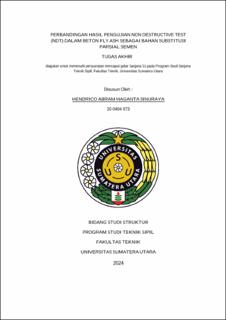Perbandingan Hasil Pengujian Non Destructive Test (NDT) dalam Beton Fly Ash sebagai Bahan Substitusi Parsial Semen
Comparison of Non Destructive Test (NDT) Results in Fly Ash Concrete as a Partial Substitute for Cement

Date
2024Author
Sinuraya, Hendrico Abram Haganta
Advisor(s)
Handana, Muhammad Agung Putra
Metadata
Show full item recordAbstract
The development of technology in the field of construction is currently very advanced, seen from the development and innovation of technology, materials, also human resources. Concrete is the most widely used construction material in construction work today. The ability or strength of concrete is determined by many things, one of which is concrete testing. Testing the compressive strength of concrete is a destructive test method. However, there are some cases where concrete samples cannot be tested in the laboratory, so it requires the collection of test samples. Some non-destructive test (NDT) methods are using the Hammer Test and UPV (Ultrasonic Pulse Velocity) to determine the strength value of concrete. The quality and capacity of concrete can be improved with certain materials such as Fly Ash which will be used in this study. Fly Ash does not have binding power like cement which will react chemically with calcium hydroxide (CaO) and produce a substance that has binding ability. This study uses an experimental method with variations in cement substitution using fly ash of 0%, 10%, 20%, 30%, 40% also 50% with an age of 28 days. The findings of this study show that the substitution of 30% variation in the Hammer Test, UPV and Compressive Strength of Core Drill results has an optimum Hammer Test value of 42.13 Mpa, Ultrasonic Pulse Velocity testing of 53.25 Mpa, and Compressive Strength testing of Core Drill results of
43.58 Mpa. For the comparison results obtained, the non-destructive test (NDT) test value that is closest to the destructive test (DT) test value is the Hammer Test with a comparison figure of 1.01.
Collections
- Undergraduate Theses [1609]
